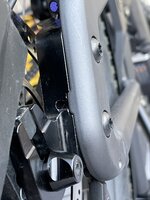How to adjust Gates belt tension on R&M Delite.
Tools Needed:
1) T30 Torx Bit and torque wrench
2) 3mm Allen hex key
3) Gates Kriket Belt tension gauge
4) flashlight
The recommended belt tension is between 28 lbs and 40 lbs. My gauge had graduations at 30 lbs, 40 lbs, 50 lbs and so on. I decided as long as it read between 30 and 40 lbs I'd be OK.
1. Loosen the four T30 Torx bolts -- two on each side of the bike (circled in red below). This allows the two brackets that hold the rear wheel hub to move back and forth.
2. There is a hex socket head screw on each side (circled in green above) that when turned moves a shuttle that, in turn, moves the brackets. Using the 3mm hex key turn the socket head screws to loosen or tighten the belt as needed. If you need to change the direction that you want the bracket to move, turn the screw in the other direction. However, for several turns you won't feel any resistance and the bracket won't reverse direction. Eventually the shuttle reaches the other side and then the bracket begins to move again.
First focus on the right side (where the belt is) and adjust the tension till the Kriket gauge shows the correct tension. Lightly tighten the two right side Torx T30 bolts.
3. Now adjust the left side bracket to make sure the wheel is running true. It helps to have the ebike upside down and use your fingers (there is a more or less fingerwidth gap on each side) to make sure that the tire is equidistant between each of the two forks. Now lightly tighten the two T30 Torx bolts on this side as well.
4. Check the belt tension again to make sure it is still where you want it and then tighten each of the 4 Torx bolts to 15 N-m.
5. The Torx bolts are supposed keep the brackets in position, not the mechanism that uses the 3mm socket head screw to move the brackets, so to relieve stress on those hex socket head screws, I decided to loosen them a bit as a final step.
Notes: You may find the rear brake disk is binding. This is easily fixed using the procedure shown here:
If your bike has mudguards you may find they are now rubbing against the tires. They can be adjusted with a 2.5mm hex wrench.


